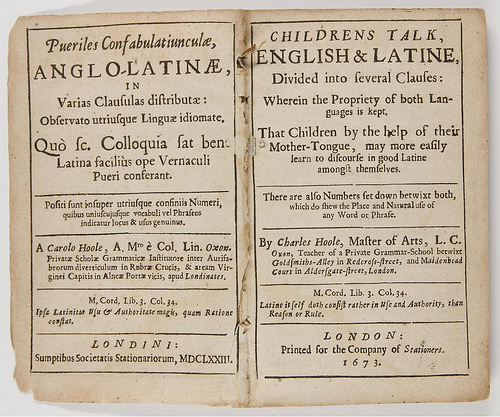Use etymology to your advantage
 |
| Most Spanish and English words share a common Latin origin Photo credit: Beinecke Library licensed CC BY-SA 2.0 |
Every word has a history regardless of its language. We all know that Spanish comes from a rich family of Romance tongues all of which have a common ancestor in Latin. Similarly, English draws from a family of Germanic languages and has closer affinities with fellow Germanic lingos such as German, Dutch, Swedish, Gaelic, etc. However, English is a unique language because it also acts as a bridge between the two language families! Over the centuries, countless words from Latin have crept into the English lexicon either directly or via French, Italian, Spanish, or Portuguese.
And this is the good news for all those who are learning Spanish. Most Spanish words either bear some sort of similarity with their English meanings, or share a common ancestor in Latin. This is why, at times when no direct visual link between a Spanish word and its English counterpart seems possible, it often helps to scratch the surface and dig into its history to see if Latin could provide any missing links.
The kitchen lexicon
 |
| La cocina Photo credit: Rowena licensed CC BY-ND 2.0 |
cafetera (coffee pot / coffeemaker) – This is a classic case of what we call “false cognates” or “false friends”. Be aware that not always do similar sounding words have similar meanings in both Spanish and English. Though cafetera sounds too close to the English word, “cafeteria,” they have absolutely unrelated meanings. While “cafeteria” means a place where you sit down to eat, usually at work or school, cafetera is the Spanish for a “coffeemaker” or a “coffee pot.” The word, cafe should help you build the necessary visual linkage if required at all.
trapo (cloth/rag) – One of the easiest ways to remember this word is to imagine the dirt that gets trapped in the fine pores of that rag when you use it to wipe the kitchen surface clean.
lavaplatos (dishwasher) – Imagine a superhero who is immune to heat or fire. Why? Well, maybe because he was born in a volcano! So heat can’t hurt him no matter what and that’s why he conveniently uses red hot lava from his volcano to wash himself whenever he needs a bath. This ensures all germs and bacteria on his body are killed by the heat of the lava and he stays impeccably clean and germ-free at all times! Now this bizzare vision should help you remember that the Spanish verb, lavar means “to clean or wash” in English. Armed with this knowledge, you should find it easy to also remember that a lavaplatos is something that washes your plates or, in other words, a “dishwasher”.
nevera (refrigerator) – Before attempting this word, learn the Spanish for “snow”. The word is nieve and the simplest way to remember this is to picture the snow-capped peaks of Sierra Nevada. Now if you remember nieve, it should be no pain to understand and remember that a device that makes it is nevera in Spanish.
batidora (mixer/blender) – If you know how they use a blender to make any kind of batter, you can easily remember why the device is called batidora in Spanish.
tetera (teapot) – A tetera holds té (tea) in the same way as a nevera holds nieve (snow or frost).
cuchara (spoon) – Before you learn the visual cue for this word, have fun knowing that cuchara is a vulgar slang for a “vagina” ( more in the sense of “cunt”) in El Salvador, Guatemala, and Venezuela. Now let’s use some etymology to remember the word. the Spanish word comes from the Latin cochleare (spoon) which, in turn, derives from another Latin word, cochlea which means a “snail or its shell.” Now, imagine using a dead snail’s shell as a make-shift spoon to scrape out fruit-pulp while eating on a hiking trip across the Amazonian jungles. Sounds gross but will stick to your memory for the very same reason!
hornilla (burner) – An oven is the hottest thing you have in your kitchen and if you need something not as hot, you have a burner (either gas or oil). Since you have already learned that an “oven” is horno in Spanish, its younger cousin should easily be an hornilla. The -illo/-illa suffix has a dimunitive effect in Spanish, reducing the effect of the main word.
sartén (skillet) – Think of the utensil you use for sautéing (a low-fat cooking over relatively high heat) some delicious potatoes and bacon! Most of us use a skillet for this purpose. What about you?
fregadero (sink) – The English word “friction” carries a sense of two surfaces rubbing against each other, kind of what happens when you scrub something like a dirty utensil; now, that’s no secret. What’s little known is the fact that this word comes from the Latin verb, fricare (to rub or chafe) which also gave Spanish its fregar, carrying the same meaning. And from this verb comes fregadero the Spanish word for “sink”, a place where you scrub your dishes clean. This relationship should help commit the word to memory easily.
By the way, the Spanish for “kitchen” is cocina which comes from coquina in Latin from where English got its verb, “to cook”. Etymology to the rescue again! In fact, the same technique can be used for practically any word, including these 32 words of things you do in your kitchen.
















0 comments:
Post a Comment